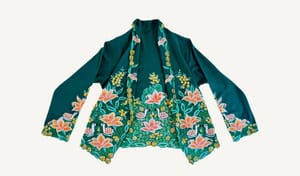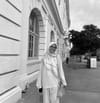INTRICATE EMBROIDERY SEWN on diaphanous Swiss voile and draped over the silhouette, the kebaya—traditionally worn by Nyonyas and Southeast Asian women—is the epitome of femininity and cultural pride. Worn daily as well as during traditional ceremonies and rites of passages such as weddings, celebrations, religious events and festivals, it also came in the early 20th century to symbolise women empowerment and nationhood.
The kebaya is a long-sleeved blouse with a front opening. The lapel of the Nyonya kebaya runs to the waist, and the blouse tapers to a dipped front. This traditional blouse in Swiss voile, silk, lace or cotton organdie comes in varying lengths and forms, and is worn with a batik or songket sarong.
The kebaya holds deep cultural significance for women and communities across Southeast Asia, symbolising refinement, femininity, tradition, cultural heritage, women’s empowerment and identity. Local customs, aesthetics and cultural practices influence regional styles. In this article, Penang Baba Nyonya terms are used for the different styles of kebaya—although other communities may use different names.
In Malaysia, the garment evolved as various communities were influenced and impacted by interactions with the West, the movement of people, commerce, history as well as social and spiritual values, ceremonies and traditions.
Since the 15th century, women in the Javanese court had been wearing the kebaya. Today, the kebaya is still worn on Kartini Day to honour Raden Adjeng Kartini, an early national activist championing women’s emancipation. In the late 20th and early 21st centuries, President Sukarno endorsed the kebaya as the official national attire for Indonesia, and First Ladies Fatimawati and Dewi Sukarno wore it during official and national events. The country’s first female president, Megawati Sukarnoputri, also frequently wore the kebaya while holding the highest office of government.






